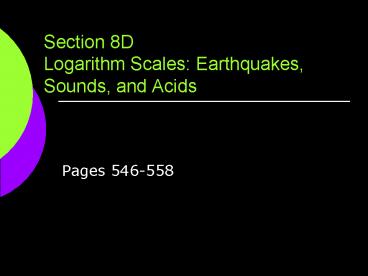Section 8D Logarithm Scales: Earthquakes, Sounds, and Acids - PowerPoint PPT Presentation
1 / 19
Title:
Section 8D Logarithm Scales: Earthquakes, Sounds, and Acids
Description:
Acidity of solutions is described by pH. Each of these measurement scales ... is the pH of a solution with a hydrogen ion concentration of 0.01 mole per liter? ... – PowerPoint PPT presentation
Number of Views:165
Avg rating:3.0/5.0
Title: Section 8D Logarithm Scales: Earthquakes, Sounds, and Acids
1
Section 8DLogarithm Scales Earthquakes, Sounds,
and Acids
- Pages 546-558
2
Measurement Scales
Earthquake strength is described in
magnitude. Loudness of sounds is described in
decibels. Acidity of solutions is described by pH.
Each of these measurement scales involves
exponential growth. e.g. An earthquake of
magnitude 8 is 32 times more powerful than an
earthquake of magnitude 7. e.g. A liquid with
pH 5 is ten times more acidic than one with pH
6.
3
Earthquake Magnitude Scale
The magnitude scale for earthquakes is defined so
that each magnitude represents about 32 times as
much energy as the prior magnitude.
Given the magnitude M we compute the
released energy E using the following
formula E (2.5 x 104) x 101.5M Energy is
measured in joules. Magnitudes have no units.
NOTE exponential growth
4
ex1/548 Calculate precisely how much more energy
is released for each 1 magnitude on the
earthquake scale (about 32 times more).
Magnitude 1 E (2.5 x 104) x 101.5(1)
Magnitude 2 E (2.5 x 104) x 101.5(2)
Magnitude 3 E (2.5 x 104) x 101.5(3)
For each 1 magnitude, 101.5 31.623 times more
energy is released.
5
ex2/548 The 1989 San Francisco earthquake, in
which 90 people were killed, had magnitude 7.1.
Compare the energy of this earthquake to that of
the 2003 earthquake that destroyed the ancient
city of Bam, Iran, which had magnitude 6.3 and
killed an estimated 50,000 people.
SF in 1989 with M7.1 E (2.5 x 104) x
101.5(7.1) 1.11671E15 joules
Iran in 2003 with M6.3 E (2.5 x 104) x
101.5(6.3) 7.04596E13 joules
Since 1.11671E15/7.04596E13 15.8489464, we say
that the SF quake was about 16 times more
powerful than the Iran quake.
6
Earthquake Magnitude Scale
Given the magnitude M we compute the
released energy E (joules) using the following
formula E (2.5 x 104) x 101.5M
Given the released energy E, how do we compute
the the magnitude M?
Use common logarithms
7
Common Logarithms (page 531)
log10(x) is the power to which 10 must be raised
to obtain x. log10(x) recognizes x as a power of
10 log10(x) y if and only if 10y x
log10(1000) 3 since 103 1000. log10(10,000,0
00) 7 since 107 10,000,000. log10(1) 0
since 100 1. log10(0.1) -1 since 10-1
0.1. log10(30) 1.4777 since 101.4777 30.
calculator
8
Common Logarithms (page 531)
9
Practice with Logarithms (page 533)
23/533 100.928 is between 10 and 100. 25/533
10-5.2 is between 100,000 and 1,000,000. 27/533
is between 0 and 1. 29/533
log10(1,600,000) is between 6 and 7. 31/533
log10(0.25) is between 0 and 1.
10
Properties of Logarithms (page 531)
log10(x) is the power to which 10 must be raised
to obtain x. log10(x) recognizes x as a power of
10 log10(x) y if and only if 10y x
log10(10x) x log10(xy) log10(x)
log10(y) log10(ab) b x log10(a)
Practice (page 533)
11
Earthquake Magnitude Scale
Given the magnitude M we compute the
released energy E (joules) using the following
formula E (2.5 x 104) x 101.5M
Given the released energy E, how do we compute
the the magnitude M? log10E log10(2.5 x
104) x 101.5M log10E log10(2.5 x 104)
log10(101.5M) log10E 4.4 1.5M
12
Earthquake Magnitude Scale
Given the magnitude M we compute the
released energy E (joules) using the following
formula E (2.5 x 104) x 101.5M
exponential
Given the released energy E (joules), we compute
the the magnitude M using the following formula
log10E 4.4 1.5M
logarithmic
More Practice 24/554 E 8 x 108 joules
13
Typical Sounds in Decibels
decibels increase by 10s and intensity is
multiplied by 10s.
14
Decibel Scale for Sound
The loudness of a sound in decibels is defined by
the following equivalent formulas
KEY How does sound compare to softest audible
sound?
15
More Practice
25/554 How many times as loud as the softest
audible sound is the sound of ordinary
conversation? Verify the decibel calculation on
page 549.
27/554 What is the loudness, in decibels, of a
sound 20 million times as loud as the softest
audible sound?
29/554 How much louder (more intense) is a
25-dB sound than a 10-dB sound?
16
pH Scale for Acidity
The pH is used by chemists to classify substances
as neutral, acidic, or basic/alkaline. Pure
Water is neutral and has a pH of 7. Acids have a
pH lower than 7. Bases have a pH higher than 7
17
The pH Scale
The pH Scale is defined by the following
equivalent formulas
pH -log10H or H 10-pH
where H is the hydrogen ion concentration in
moles per liter.
18
Practice
37/555 What is the hydrogen ion concentration of
a solution with pH 7.5?
39/555 What is the pH of a solution with a
hydrogen ion concentration of 0.01 mole per
liter? Is this solution an acid or base?
19
- Homework
- Pages 554 - 555
- 22,24, 28, 38,40































